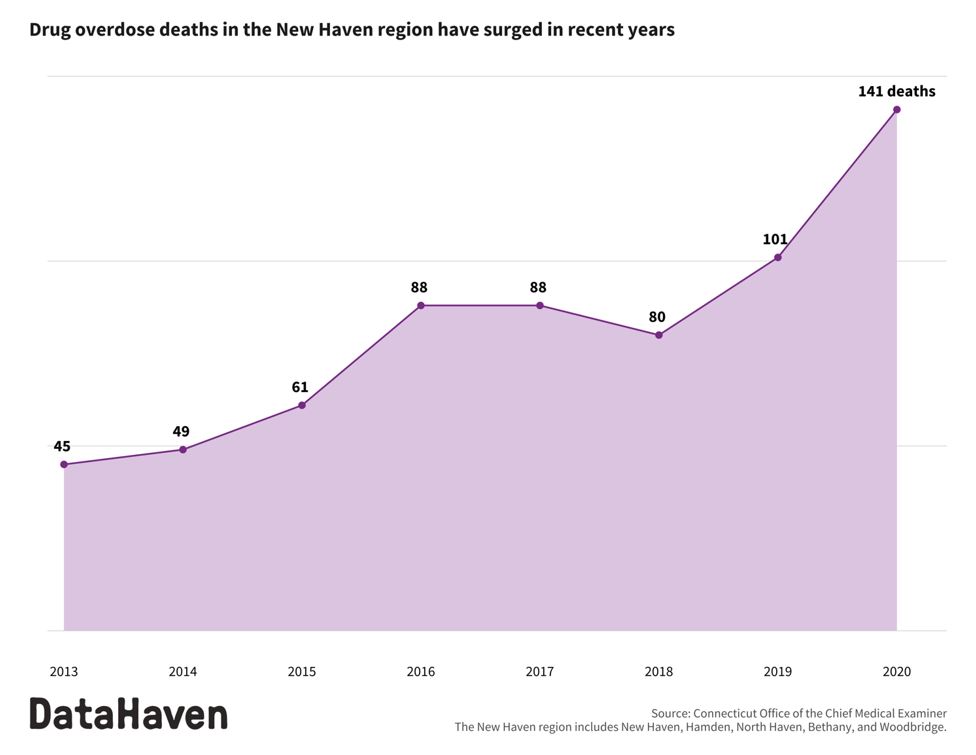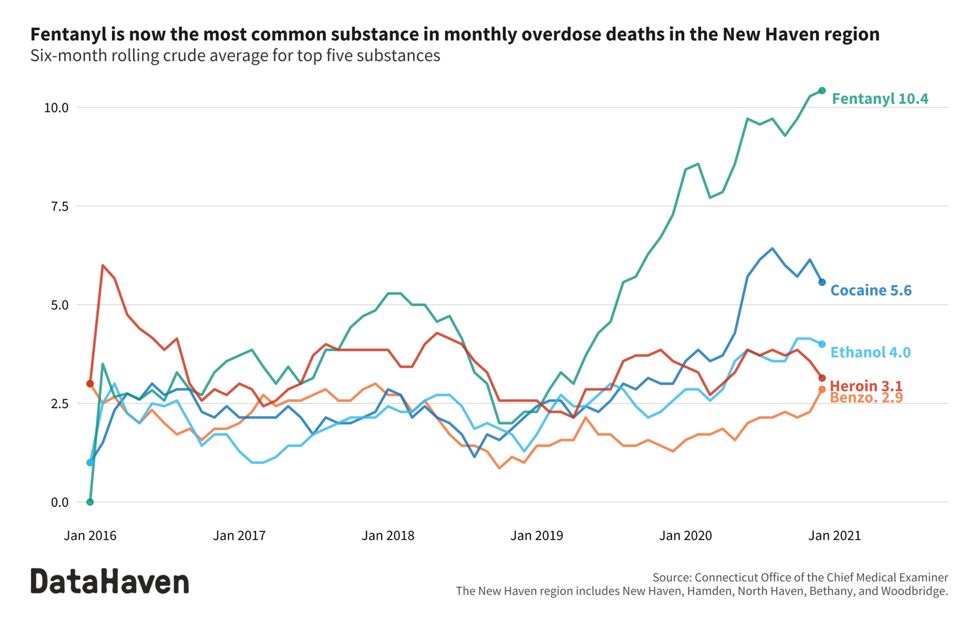All DataHaven Programs, Health
Fatal overdoses in the New Haven area increased by 40 percent in 2020: New report explores root causes and recommends prevention strategies
PRESS RELEASE
For Release August 24, 2021
Press contact
Kelly Davila, Senior Research Associate, DataHaven
Email: kelly [at] ctdatahaven.org
According to a new report by DataHaven (available at ctdatahaven.org/od2a), fatal overdoses were at a record-high during 2020, with a total of 141 overdose deaths—up from the previous record-high of 101 deaths in 2019. The report, commissioned by Quinnipiack Valley Health District (QVHD) in partnership with the New Haven Health Department (NHHD), summarizes overdose data for the towns covered by those two regions, including Bethany, Hamden, New Haven, North Haven, and Woodbridge.
“This increase occurred as public health organizations revised harm prevention strategies to slow the spread of COVID-19. Individuals who may have been exposed to someone positive for COVID-19 were recommended to isolate or quarantine, yet this had a negative impact on a key harm reduction message of not using drugs alone. QVHD is working with our local partners to increase awareness in risk reduction strategies and to connect residents without stigma to community resources and supports”, says Karen Ann Wolujewicz, Director of Health at Quinnipiack Valley Health District.
Nationwide, the CDC estimates that more than 93,000 deaths were caused by overdose in 2020—an increase of 30 percent over 2019. The 40 percent increase in local overdose deaths in the QVHD/NHHD towns eclipses the nationwide trend.
The sharp rise in local overdose fatalities is related to the prevalence of the synthetic opioid, fentanyl. As recently as 2016, fentanyl was an emerging substance of concern, but it is now by far the most common drug involved in overdose fatalities. Last year, fentanyl was involved in 94 percent of overdose deaths. There are more than 10 overdose deaths involving fentanyl every month in the region.
But data indicate that substance users may not be aware of how widespread fentanyl is in the local drug supply. The DataHaven report summarizes the responses of a 2021 survey of people who had overdosed in the past year. Of those surveyed, only 9 percent thought fentanyl was involved in their last overdose. Kelly Davila, lead author of the report and Senior Research Associate at DataHaven, commented that “the disconnect between users’ perceptions of how widespread fentanyl is compared to the data from fatal overdoses was striking. It suggests that users might not be aware of the product they’re using or how potent it might be.” To help users determine if drugs have been contaminated with fentanyl, rapid test strips are available through harm prevention programs, often for no cost.
“I applaud this report for focusing on understanding perspectives of people who use drugs” says Dr. Mehul Dalal, Community Services Administrator for the City of New Haven. “It reinforces the approach of the New Haven Harm Reduction Taskforce, which is focused on engagement, education, and meeting people where they are.”
Support and resources more important than ever
Fortunately, medication-assisted treatment is an evidence-based approach that combines medication and behavioral therapy to treat substance use disorder. There are approximately 1,000 adults per 1 medication-assisted treatment provider in the five-town region—triple the average number of providers in the state. In the five-town region, admissions for opioid treatment increased 44 percent between 2014 and 2018. In 2018, Connecticut ranked third in the nation for opioid treatment admissions behind Maryland and Delaware
Naloxone, also known as Narcan, is a safe and effective harm prevention drug that can reverse overdose related to opioids, including heroin and fentanyl. It is readily available through harm prevention programs, such as QVHD’s Overdose Data 2 Action program; retail pharmacies without a prior prescription or can be prescribed by physicians. Naloxone is covered by health insurance plans including HUSKY/Medicaid. Despite its availability and ease of use, it is not in wide circulation in the general public. Only 32 percent of surveyed substance users knew where to obtain naloxone, and only 17 percent of overdose related emergency dispatch calls involved a bystander administering the first dose of naloxone.
Low income, high unemployment, and chronic housing instability are already known to play a role in problematic substance use. Each of these needs were worsened by the pandemic-related economic downturn. The report highlights several neighborhoods which experience the compound effects of low access to social and economic resources and high rates of overdose. Due to a legacy of racism in federal, state, and local policy, these communities are also disproportionately communities of color.
The dramatic increase in overdose deaths in 2020 is likely related to the effects of the ongoing COVID-19 pandemic. Public health concerns during the pandemic’s deadly first wave last spring limited in-person outreach and treatment efforts, although many of these programs are back underway. With an uneven economic recovery threatened by a slow vaccine uptake, and the sunset of expanded benefits programs, without continued efforts and outreach, 2021 may turn out to be another record-breaking year for drug-related fatalities.
We all have the power to change this narrative by connecting those impacted to necessary resources. Anyone can overdose, anyone can save a life; learn more about local health’s Overdose Data to Action initiatives by visiting www.connectgnh.org.


